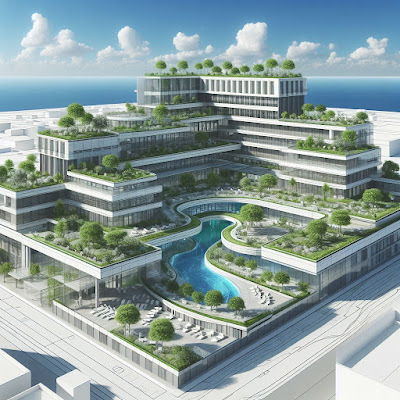In the realm of healthcare, the importance of architecture and design cannot be overstated. From hospitals and clinics to nursing homes and outpatient facilities, the layout, aesthetics, and functionality of healthcare spaces play a crucial role in patient outcomes, staff efficiency, and overall wellness. In this post, we'll delve into the fascinating world of healthcare architecture and design, examining its principles, innovations, applications, and the profound impact it has on the delivery of healthcare services.
 |
| Healthcare Architecture and Design |
Introduction: The Power of Design in Healthcare
Healthcare architecture and design go beyond aesthetics; they are essential components of a healing environment that promotes patient comfort, safety, and well-being. By integrating evidence-based design principles, innovative technologies, and human-centered approaches, healthcare facilities can enhance the patient experience, improve staff satisfaction, and optimize clinical outcomes.
Design Principles in Healthcare Architecture
At the heart of healthcare architecture are several key design principles:
Patient-Centered Design: Patient-centered design focuses on creating spaces that prioritize the needs, preferences, and experiences of patients, fostering a sense of dignity, empowerment, and control over their healthcare journey.
Safety and Infection Control: Healthcare facilities must adhere to strict safety and infection control standards to minimize the risk of healthcare-associated infections (HAIs) and ensure the well-being of patients, staff, and visitors.
Efficiency and Workflow: Efficient design and workflow optimization are essential for enhancing staff productivity, reducing wait times, and streamlining patient care processes within healthcare environments.
Flexibility and Adaptability: Healthcare facilities must be designed with flexibility and adaptability in mind to accommodate changes in technology, patient demographics, and healthcare delivery models over time.
Innovations in Healthcare Design
The field of healthcare architecture is constantly evolving, driven by innovations in design, technology, and healthcare delivery models. Some notable innovations include:
Healing Gardens and Biophilic Design: Incorporating elements of nature, such as natural light, greenery, and outdoor spaces, has been shown to promote healing, reduce stress, and improve patient outcomes.
Telehealth Integration: As telehealth and virtual care become increasingly prevalent, healthcare facilities are incorporating dedicated spaces for telehealth consultations, remote monitoring, and virtual visits to accommodate the changing landscape of healthcare delivery.
Modular Construction: Modular construction techniques offer speed, cost-effectiveness, and flexibility in healthcare facility design, allowing for rapid deployment of modular units for emergency response, temporary facilities, or expansion projects.
Technology Integration: Advanced technologies, such as augmented reality (AR), virtual reality (VR), and smart building systems, are being integrated into healthcare facilities to enhance patient engagement, support clinical decision-making, and improve operational efficiency.
Applications of Healthcare Architecture and Design
Healthcare architecture and design have diverse applications across various healthcare settings, including:
Hospitals and Medical Centers: Hospital design encompasses a wide range of specialized areas, including emergency departments, operating rooms, patient rooms, and diagnostic imaging suites, each requiring unique design considerations to optimize patient care and safety.
Clinics and Outpatient Facilities: Outpatient clinics and medical offices must be designed to accommodate the needs of diverse patient populations, support multidisciplinary care teams, and provide a welcoming and accessible environment for patients and visitors.
Long-Term Care and Senior Living: Designing environments for long-term care and senior living facilities requires a focus on creating spaces that promote independence, social engagement, and quality of life for residents while addressing the unique needs of aging populations.
Wellness and Behavioral Health Centers: Wellness centers and behavioral health facilities prioritize holistic care, mental health support, and wellness promotion through thoughtful design elements, therapeutic spaces, and access to nature.
The Impact of Healthcare Architecture and Design
The impact of healthcare architecture and design extends far beyond aesthetics; it influences patient outcomes, staff satisfaction, and organizational performance. By creating healing environments that prioritize safety, comfort, and efficiency, healthcare facilities can enhance the overall quality of care and contribute to positive health outcomes for individuals and communities.
Challenges and Considerations
Despite its many benefits, healthcare architecture and design face several challenges and considerations, including:
Cost Constraints: Balancing design innovation with budget constraints can be challenging for healthcare organizations, particularly in the face of rising construction costs and limited resources.
Regulatory Compliance: Healthcare facilities must adhere to strict regulatory requirements, building codes, and standards for safety, accessibility, and infection control, which can influence design decisions and project timelines.
Sustainability and Resilience: Incorporating sustainable design principles and resilience strategies into healthcare facilities is essential for minimizing environmental impact, reducing operating costs, and enhancing long-term sustainability.
Community Engagement: Engaging stakeholders, including patients, families, staff, and community members, in the design process is crucial for ensuring that healthcare facilities meet the needs and preferences of their intended users.
The Future of Healthcare Architecture and Design
As healthcare continues to evolve, the future of healthcare architecture and design holds tremendous potential for innovation, collaboration, and transformation. By embracing human-centered design principles, leveraging advanced technologies, and prioritizing sustainability and wellness, healthcare facilities can create environments that support the delivery of high-quality, patient-centered care for generations to come.
Conclusion: Designing for Health and Healing
In conclusion, healthcare architecture and design play a pivotal role in shaping the future of healthcare delivery, patient experience, and population health. By embracing innovative design solutions, integrating technology, and prioritizing the needs of patients and caregivers, healthcare facilities can create healing environments that promote health, wellness, and healing for all.






